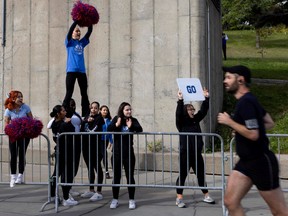There is no guarantee that any strategy will reduce risk or effectively reduce knee pain.

Postmedia may earn an affiliate commission from purchases made through our links on this page.
.
Now that the marathon season is coming to an end, there are many runners with sore knees.
Announcement 2
.
Knees account for 17 percent of all injuries, making them the most common source of pain among those who hit the pavement. For some it is something new, but for others it is a recurrent pain that can last days or weeks, with discomfort that settles during or after a race.
.
There is no shortage of opinion within the running community on how knee pain should be treated. Ice packs, stretching regimens, shoe selection, warm-up routines, manual therapy, orthotics, strength training, stride retraining, and reduction in training hours, mileage, or These are often common suggestions, but there is no guarantee that any strategy will reduce risk or reduce risk effectively. reduce knee pain.
Even among the research community, there is little consensus regarding a preferred treatment, despite the large number of published studies. Noting that it had been more than a decade since anyone reviewed the latest findings, a team of Australians from La Trobe University decided to take an evidence-based approach to knee pain by examining the latest studies and strategies on runners and knee pain.
Announcement 3
.
“The high incidence and burden of running-related knee injuries highlights the need for an updated evidence synthesis for prevention and management strategies to inform clinical practice and guide future research,” the researchers said in a recent article published in the British Journal Sports Medicine.
Narrowing their selection down to 30 studies focused on pain prevention or control, with a combined sample of 11,549 novice and recreational runners, the results offered some exciting new strategies for improving knee health. They also dispelled some popular theories that have been slow to die down.
One of the most effective tactics to decrease your risk of knee pain is one of the easiest to implement. Self-directed verbal cues to “run smoother” and “make footsteps quieter” resulted in a two-thirds reduction in injury risk. Changes in a runner’s stride are the latest trend in the prevention and treatment of knee injuries. In addition to a softer stride, strategies like switching from heel-first to midfoot contact and increasing running cadence (the number of strides per minute) show promise when it comes to relieving lower back aches and pains. lower body.
Announcement 4
.
As far as outdated trends go, the idea that the right footwear is the key to staying injury free is fast becoming more of a myth than a fact.
“Our findings indicated that running shoe prescription, which includes minimalist, traditional/neutral soft midsole, hard midsole, and motion control footwear, does not influence injury risk,” the researchers said.
What about knee pain that has already started? Is there anything that can help you get back to running without pain? Once again, stride retraining is worth a try. Evidence showed that increasing your cadence by 10 percent can help lessen knee pain. Manual therapy directed at the hip and knee, and the addition of orthotics (therapeutic shoe inserts) to reduce the amount of foot roll that occurs with each touchdown, is also effective.
ad 5
.
Determine your cadence by counting the number of times a single foot hits the ground in 30 seconds. Double that number for a full 60-second measurement, then double it again to account for both feet. If you’re using an Apple or Garmin smartwatch, they both measure cadence, making it easier than counting manually.
Most recreational runners rack up between 150 and 170 spm (steps per minute), and experts suggest 160 to 180 spm is the preferred goal, although height, weight, and leg length all play a role. individualization of the optimal cadence. The lower your cadence, the longer your stride and the more likely you are to land heel first with your foot in front of your hips. A faster cadence repositions the strike of the foot under the hips and shifts the touch down closer to the midfoot, resulting in a lower bounce, lower impact run that is easier on the knees.
ad 6
.
Once you’ve determined your cadence, heed the findings reported by Australian researchers and try gradually increasing your cadence by 10 percent. Run with shorter, faster steps, visualizing keeping your feet below your hips instead of taking long strides. It’s also helpful to take off your headphones while running and listen to every footfall. If your feet sound heavy, repeat the “run quietly” mantra to soften each step and further reduce the impact.
Keep in mind that stride retraining requires a mindful approach, especially when fatigue sets in. Evaluate your cadence manually a few times during your run, or check the stats on your smartwatch when you get home. Knowing how your cadence changes along the route lets you know where you can improve.
You can also track progress by checking with your knees. The combination of a softer landing and a shorter, more efficient stride may be just what the doctor ordered when it comes to pain-free running.
-
The runner’s high and how to find your flow
-
Add some energy to your running routine
-
Now that you’re a runner, keep up the pace by varying your routine




